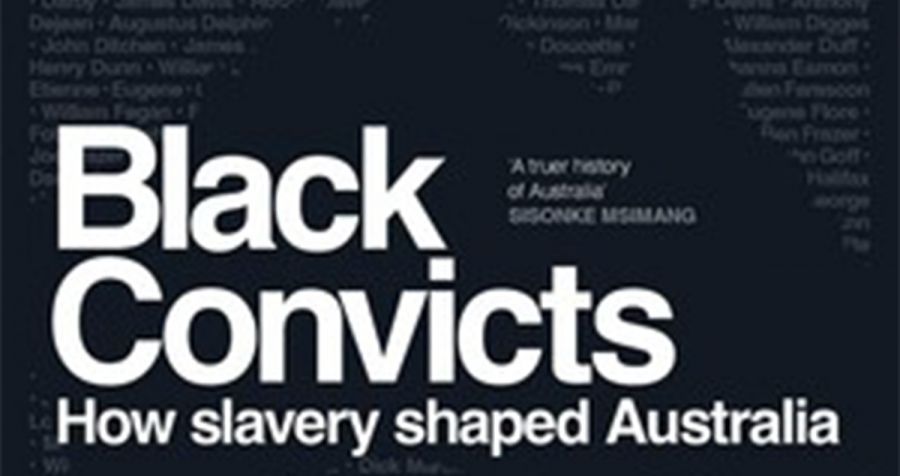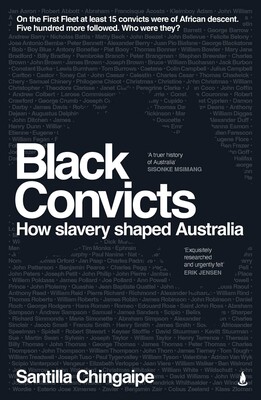
- Free Article: No
- Contents Category: Slavery
- Review Article: Yes
- Article Title: Slavery’s stain
- Article Subtitle: A shameful aspect of the national story
- Online Only: No
- Custom Highlight Text:
This is not a book for Scott Morrison, who, as prime minister, declared that Australian history was free of the stain of slavery. Santilla Chingaipe proves otherwise. As she states in her introduction, a key theme of Black Convicts is the exploration of ‘how slavery shaped modern Australia’. In the context of this book, ‘slavery’ is both a specific and an umbrella term for different forms of labour exploitation pursued by the British empire between the 1600s and the 1800s. Chingaipe argues that slavery, convictism, and indentured servitude were linked through a fundamental premise: the abuse and exploitation of people for financial gain. Her primary focus is on convicts, as the title suggests, and how Black men, women, and children transported to Australia ultimately were victims of the same system that enslaved their forebears. These convicts were not chattel slaves – many had once known liberty, and would again – but the direction of their lives, in common with the lives of Black people kept as property and forced to labour on plantations in the Americas, was shaped by colonial masters who placed profit over morality.
- Featured Image (400px * 250px):

- Alt Tag (Featured Image): Seumas Spark reviews ‘Black Convicts: How slavery shaped Australia’ by Santilla Chingaipe
- Book 1 Title: Black Convicts
- Book 1 Subtitle: How slavery shaped Australia
- Book 1 Biblio: Scribner, $34.99 pb, 331 pp
- Book 1 Cover Small (400 x 600):

- Book 1 Cover (800 x 1200):

- Book 1 Readings Link: https://www.readings.com.au/product/9781761107238/black-convicts--santilla-chingaipe--2024--9781761107238#rac:jokjjzr6ly9m
This is an important and often shocking story, and one that should be better known. Chingaipe’s research has identified around five hundred Black people who were shipped to Australia as convicts between 1788 and 1840. Some of their stories she follows closely, or as closely as limited sources allow, revealing a remarkable diversity of background and circumstances. One story is that of William ‘Billy’ Blue, a convict of Black American heritage transported from London to Sydney in 1801. He was released in 1803, and went on to operate one of the earliest ferry services on Sydney harbour.
 William 'Billy' Blue, 1834 (J.B. East, State Library of New Sourh Wales via Wikimedia Commons)
William 'Billy' Blue, 1834 (J.B. East, State Library of New Sourh Wales via Wikimedia Commons)
Another account is that of John ‘Black’ Caesar. Possibly he was from Madagascar, or the Caribbean: his heritage is unclear. In England, Caesar was found guilty of burglary and theft. His punishment was transportation to Australia and seven years’ imprisonment. After arriving in Sydney in 1788 on the First Fleet, Caesar’s life became a cycle of escape and arrest. When on the run, he turned to armed robbery, a path that ensnared him in a cycle of violence. Colonial authorities placed a bounty on his head, and soon enough he was dead, shot in 1796 by a man wanting the reward. History remembers Caesar as Australia’s first bushranger.
In relating Blue’s and Caesar’s stories, Chingaipe is careful to show the degree to which circumstances were ranged against Black people, and how prejudice is represented, or ignored, in what she refers to as the ‘colonial archive’. In Caesar’s case, she encourages readers to look beyond the notoriety of his title as Australia’s first bushranger to consider what led him to this life. This is a strength of the book. Chingaipe is right to wonder what history hasn’t told us about these and other Black lives.
Chingaipe is to be congratulated for her role in documenting these histories, and with such conviction. A cover puff declares this book to be ‘exquisitely researched and urgently felt’, and that seems about right. A good deal of careful research has gone into this work, and the author’s passion for and commitment to her subject are clear. The book echoes with righteous anger.
However, there are missteps in the narrative. The most distracting of these concern Chingaipe’s historical approach. Often, she seems determined to pursue a narrow view of the past, with each twist and turn filed in one column or another. To write history in this way is to limit its potential to inform and change minds. History is never so tidy: its power and seduction often lie in its nuances and subtleties, in the complex and sometimes inconvenient details that confound an argument or idea. The best and most convincing historical writing embraces this murky territory, seeking to understand vagaries and complications.
Possibly Chingaipe’s approach would not have much mattered, if not for the judgements she offers on the historian’s craft. While much of what she has to say about the practice of history is insightful and valuable, especially on the racism and ignorance that has obscured and silenced Black voices, her own writing includes some of the limitations she identifies in the historical record. For all its merits, Black Convicts can be heavy on generalisation and cavalier in its disregard of context. There is a tendency to mix wise observation and throwaway comment. Chingaipe writes: ‘Today, echoes of forced exile (which has its roots in colonial history) can be found in migration policies in Britain and some of its former colonies like Australia.’ This blithe claim about forced exile, a cruelty considerably older than the colonial era, diminishes the sentence, detracting from a cogent observation on the moral emptiness of modern migration policy.
This example is not isolated. Often the writing is loose, some claims both careless and too neat. A recurrent theme in this book is that many modern ills have their origins in the colonial slave trade. In places, Chingaipe makes the case persuasively. How-ever, this line of enquiry can present as naïve and, perversely, too generous. To be sure, the slave trade that supported European colonial empires offers a particularly confronting and brutal example of people’s capacity for hurt and prejudice, as Chingaipe shows, but the capacity for hate is as old as history. The book offers little sense of wider context, of a time before the colonial slave trade. Readers would be forgiven for thinking that slavery itself was essentially a colonial phenomenon of recent centuries, and not both an ancient, and continuing, practice. The absence of a longer perspective does not reduce the power of Chingaipe’s examples, or the fundamental importance of her message, but it does diminish the force of the argument.
The book has curious inclusions. At various points in the text, Chingaipe describes physical characteristics of her interviewees. One, for instance, is ‘very well put together’, whatever that means. These descriptions, without discernible relevance, are bizarre additions. Here and elsewhere a stronger editorial hand was needed. The first person is inserted into passages where it serves little or no purpose, and the effect can be awkward: a blend of historical narrative and personal observation that is neither one thing nor the other. A stricter editor would have intervened more, tightening the text and reducing its length.
In another book, these flaws might be too great to overcome. Here, they are more distractions than insuperable hurdles, thanks to the power and significance of the Black histories that Chingaipe has uncovered. These histories, pieced together from scraps of information, deserve attention, and they should bear on how Australians understand their past and identity. Slavery did shape Australia, as the subtitle declares, and it is for Australians to confront this shameful aspect of the national story. If Chingaipe’s aim was to help force this reckoning, her book succeeds.


Comments powered by CComment